Study on Construction Mechanical Effect and Optimization of Large-Span Variable Cross-Section of Railway Tunnel
Abstract
:1. Introduction
2. Engineering Situations
3. Numerical Simulation Analysis of Construction Scheme
3.1. Numerical Calculation Model
3.2. Analysis of Lining Stress
3.3. Analysis of Surrounding Rock Displacement
3.4. Analysis of Plastic Zone of Surrounding Rock
4. Optimization Analysis of Construction Scheme
4.1. The Construction Procedures of the Upper Step Expansion Excavation Method
4.2. Analysis of Surrounding Rock Stress
4.3. Analysis of Lining Stress
4.4. Analysis of Surrounding Rock Deformation
4.5. Analysis of Plastic Zone of Surrounding Rock
5. Field Monitoring Measurement Analysis
5.1. Field Monitoring Scheme
5.2. Analysis of Displacement Monitoring
6. Conclusions
- (i)
- Based on the results of numerical simulation analysis, it is proposed to set up a transition section at the variable cross-section position. The three-step temporary inverted arch method is used for construction. It was found that this solution could reduce the vertical displacement of the arch roof in the variable cross-section section during excavation. Establishing horizontal braces can better control the horizontal displacement of the excavation tunnel face, and there is no large-area stress concentration. Due to the headwall at the variable cross-section, the displacement of the right side wall at the variable cross-section will increase. The deformation of the right side wall of the widened section is weakened.
- (ii)
- In view of the difficulties in tunnel construction, two optimized expansion excavation methods were analyzed, and the support portal method was selected for construction. Through field implementation, it was found that this method can better connect the excavation working surface and can also solve the problem of inability to implement advanced support. No surrounding rock collapse occurred during the construction process, effectively suppressing the deformation and stress changes caused by the excavation of the tunnel face.
- (iii)
- Through the compilation and analysis of field monitoring data, it was found that the changes in the surrounding rock arch roof settlement, arch waist, and arch foot convergence tend to be consistent. All showed a trend of rapid increase in the early stage, slowing down in the mid-term, and gradually stabilizing in the later stage. The feasibility and rationality of the numerical simulation results and optimized construction scheme were verified. It solves the problem of stress concentration and deformation of surrounding rocks near the variable cross-section position of the tunnel that is difficult to control.
Author Contributions
Funding
Data Availability Statement
Conflicts of Interest
References
- Fan, S.; Song, Z.; Xu, T.; Wang, K.; Zhang, Y. Tunnel deformation and stress response under the bilateral foundation pit construction: A case study. Arch. Civ. Mech. Eng. 2021, 21, 109. [Google Scholar] [CrossRef]
- Song, S.; Huo, R. Optimization Research and Application of Empty Hole Straight Cut Blasting Scheme for Railway Tunnel. Blasting 2023, in press. Available online: https://link.cnki.net/urlid/42.1164.TJ.20231024.1328.002 (accessed on 16 October 2023).
- Editorial Department of China Journal of Highway and Transport. Review on China’s Traffic Tunnel Engineering Research: 2022. China J. Highw. Transp. 2022, 35, 1–40. [Google Scholar] [CrossRef]
- Zhao, Y.; Li, P. A statistical analysis of China’s traffic tunnel development data. Engineering 2018, 4, 3–5. [Google Scholar] [CrossRef]
- Zhu, Y.; Zhou, J.; Zhang, B.; Wang, H.; Huang, M. Statistical analysis of major tunnel construction accidents in China from 2010 to 2020. Tunn. Undergr. Space Technol. 2022, 124, 104460. [Google Scholar] [CrossRef]
- Sousa, R.; Einstein, H. Lessons from accidents during tunnel construction. Tunn. Undergr. Space Technol. 2021, 113, 103916. [Google Scholar] [CrossRef]
- Wang, X.; Lai, J.; Qiu, J.; Xu, W.; Wang, L.; Luo, Y. Geohazards, reflection and challenges in mountain tunnel construction of China: A data collection from 2002 to 2018. Geomat. Nat. Hazards Risk 2020, 11, 766–785. [Google Scholar] [CrossRef]
- Tian, X.; Song, Z.; Zhang, Y. Monitoring and reinforcement of landslide induced by tunnel excavation: A case study from Xiamaixi tunnel. Tunn. Undergr. Space Technol. 2021, 110, 103796. [Google Scholar] [CrossRef]
- Zhao, F. Study on Mechanical Behavior and Surrounding Rock Classification of Variable Cross-Section Double-Line Parallel Metro Tunnels. Master’s Thesis, Shijiazhuang Tiedao University, Shijiazhuang, China, 2020. [Google Scholar]
- Wang, Y. Study on Construction Mechanics of Shallow-Buried Large-Span Variable Section Subway Tunnel Group. Master’s Thesis, Shandong University, Jinan, China, 2018. [Google Scholar]
- Guo, H.; Chen, L.; Zhang, L.; Wang, Z.; Zhong, D.; Yang, L. Deformation Characteristics and Reinforcement Methods in Variable Cross-section at Emergency Parking Belt in Soft Rock Mass Highway Tunnel. Sci. Technol. Eng. 2022, 22, 15765–15774. [Google Scholar]
- Taromi, M.; Eftekhari, A.; Hamidi, J.; Aalianvari, A. A discrepancy between observed and predicted NATM tunnel behaviors and updating: A case study of the Sabzkuh tunnel. Bull. Eng. Geol. Environ. 2017, 76, 713–729. [Google Scholar] [CrossRef]
- Wang, T.; Zhu, Y.; Tian, X.; Shi, F.; Zhang, L.; Lu, Y. Design method of the variable cross-section tunnel focused on improving passenger pressure comfort of trains intersecting in the tunnel. Build. Environ. 2022, 221, 109336. [Google Scholar] [CrossRef]
- Zhang, Y.; Tao, L.; Liu, J.; Zhao, X.; Guo, F.; Tan, L.; Wang, Z. Construction techniques and mechanical behavior of newly-built large-span tunnel ultra-short distance up-crossing the existing shield tunnel with oblique angle. Tunn. Undergr. Space Technol. 2023, 138, 105162. [Google Scholar] [CrossRef]
- Zeng, W.; Peng, X.; Zhang, L.; Hu, E.; Yang, W. Mechanical Characteristics of Super-Large Variable-Section Tunnel. Chin. J. Undergr. Space Eng. 2022, 18, 2062–2071+2079. [Google Scholar]
- Yao, G.; Jin, Y. Study on mechanical characteristics of large section tunnel construction in soft surrounding rock. In Proceedings of the 2021 International Conference on Smart Transportation and City Engineering, Chongqing, China, 26–28 October 2021; SPIE: Bellingham, WA, USA, 2021; Volume 12050, pp. 1040–1046. [Google Scholar] [CrossRef]
- Luo, J.; Zhang, D.; Fang, Q.; Liu, D.; Xu, T. Mechanical responses of surrounding rock mass and tunnel linings in large-span triple-arch tunnel. Tunn. Undergr. Space Technol. 2021, 113, 103971. [Google Scholar] [CrossRef]
- Yang, D.; Qian, K.; Tong, J.; Gui, D.; Wang, M. Study on Mechanical Characteristics of Super-large Section Highway Tunnel during Construction Methd Change. Mod. Tunn. Technol. 2021, 58, 216–223. [Google Scholar]
- Wu, K.; Yu, Y.; Cui, S.; Zhang, Q. Construction mechanical mechanism of shallow subway tunnel group with large-span variable cross section. Geotech. Geol. Eng. 2018, 36, 3879–3891. [Google Scholar] [CrossRef]
- Zhu, Y.; Chen, L.; Zhang, H.; Zhou, Z.; Chen, S. Physical and mechanical characteristics of soft rock tunnel and the effect of excavation on supporting structure. Appl. Sci. 2019, 9, 1517. [Google Scholar] [CrossRef]
- Xu, J.; Xie, X.; Shi, Z.; Cai, W.; Xu, D.; Xu, C. Experimental study on performance of spring damping support structure system for large deformation tunnel in soft rock. Undergr. Space 2023, in press. [CrossRef]
- Wang, X.; Zhao, W.; Wu, S. Tunnel Support Structure System and Its Synergy. J. World Archit. 2023, 7, 11–16. [Google Scholar] [CrossRef]
- Fan, S.; Song, Z.; Li, X.; Zhang, Y.; Liu, L. Investigation into the Large Deformation Mechanism and Control Technology of Variable Cross-Section Tunnel in Layered Mudstone Stratum. Buildings 2022, 13, 110. [Google Scholar]
- Zhou, Z.; Zhao, J.; Tan, Z.; Zhou, X. Mechanical responses in the construction process of super-large cross-section tunnel: A case study of Gongbei tunnel. Tunn. Undergr. Space Technol. 2021, 115, 104044. [Google Scholar] [CrossRef]
- Qiao, S.; Cai, Z. Study on the Characteristics of Surrounding Rock-support in Variable Cross Section Construction of Extra-long Highway Tunnel. Chin. J. Undergr. Space Eng. 2021, 17, 275–282. [Google Scholar]
- Yang, C.; Wei, L.; Mo. H.; Chen, J. Mechanical Response of Immersed Tunnel with Variable Section during Temporary Support. Chin. J. Undergr. Space Eng. 2020, 16, 1504–1510+1562. [Google Scholar]
- Luo, Y.; Chen, J.; Shi, Z.; Li, J.; Liu, W. Mechanical characteristics of primary support of large span loess highway tunnel: A case study in Shaanxi Province, Loess Plateau, NW China primary. Tunn. Undergr. Space Technol. 2020, 104, 103532. [Google Scholar] [CrossRef]
- Zhou, H.; He, C.; Wang, X.; Chen, Y.; Li, J. Assessment of the seismic response of shallow buried elliptical tunnels. J. Earthq. Eng. 2023, 27, 465–487. [Google Scholar] [CrossRef]
- Tang, B.; Cheng, H.; Tang, Y.; Zheng, T.; Yao, Z.; Wang, C.; Rong, C. Supporting design optimization of tunnel boring machines-excavated coal mine roadways: A case study in Zhangji, China. Processes 2020, 8, 46. [Google Scholar] [CrossRef]
- Yang, T.; Xiong, S.; Liu, S.; Liu, Y.; Zhao, H.; Li, Y. Numerical analysis of the influence of deep foundation pit construction on adjacent subway stations in soft soil areas. Adv. Civ. Eng. 2022, 2022, 6071868. [Google Scholar] [CrossRef]
- Tian, X.; Song, Z.; Wang, H.; Zhang, Y.; Wang, J. Evolution characteristics of the surrounding rock pressure and construction techniques: A case study from Taoshuping tunnel. Tunn. Undergr. Space Technol. 2022, 125, 104522. [Google Scholar]
- Jia, Y.; Xia, Y.; Chen, X.; Zhou, Y.; Han, X.; Zhou, S. Force and deformation characteristics during the reconstruction and expansion of shallow single-tube tunnels into large-span multiarch tunnels. Adv. Mater. Sci. Eng. 2019, 2019, 2783784. [Google Scholar] [CrossRef]
- Vetter, S.; Galli, M.; Steiner, P. Refurbishment of the Kuckuckslay tunnel–Current experience in the use of the “Tunnel-im-Tunnel-Methode”. Geomech. Tunn. 2020, 13, 557–565. [Google Scholar] [CrossRef]
- Naghadehi, M.Z.; Thewes, M.; Lavasan, A.A. Face stability analysis of mechanized shield tunneling: An objective systems approach to the problem. Eng. Geol. 2019, 262, 105307. [Google Scholar] [CrossRef]
- Kim, K.Y.; Jo, S.A.; Ryu, H.H.; Cho, G.C. Prediction of TBM performance based on specific energy. Geomech. Eng. 2020, 22, 489–496. [Google Scholar] [CrossRef]
- Q/CR9218-2015; Technical Specification for Monitoring Measurement of Railway Tunnel. Standardization Administration of the People’s Republic of China: Beijing, China, 2015.
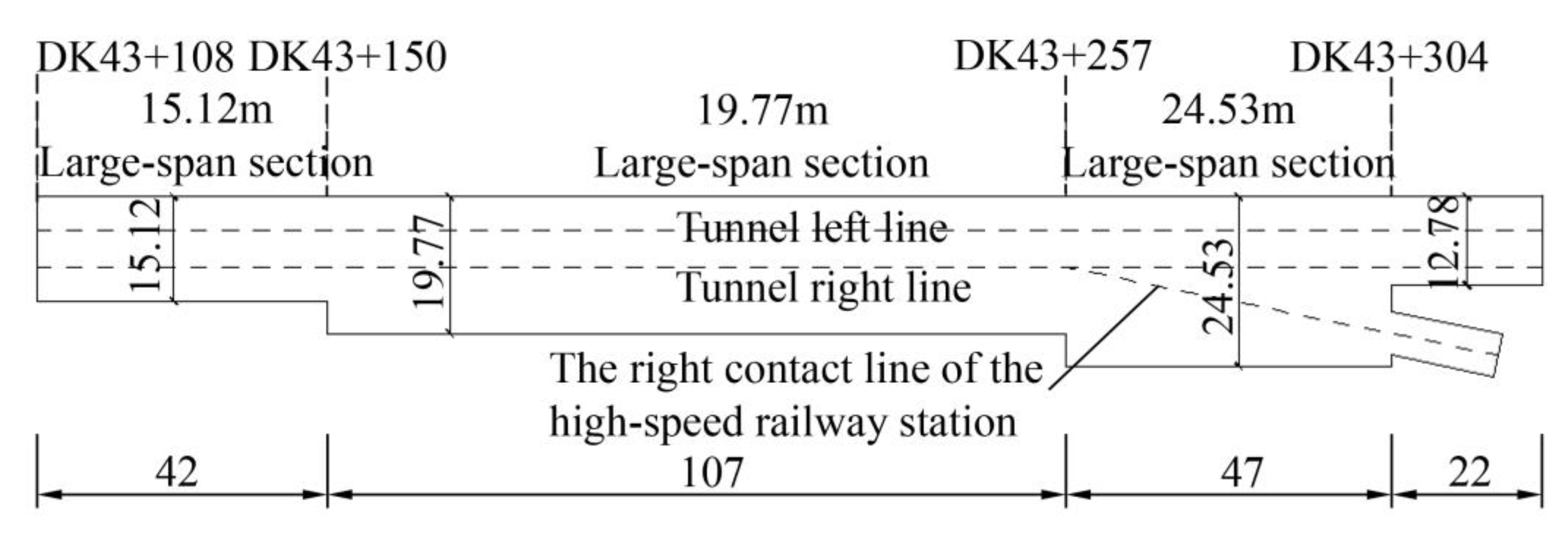
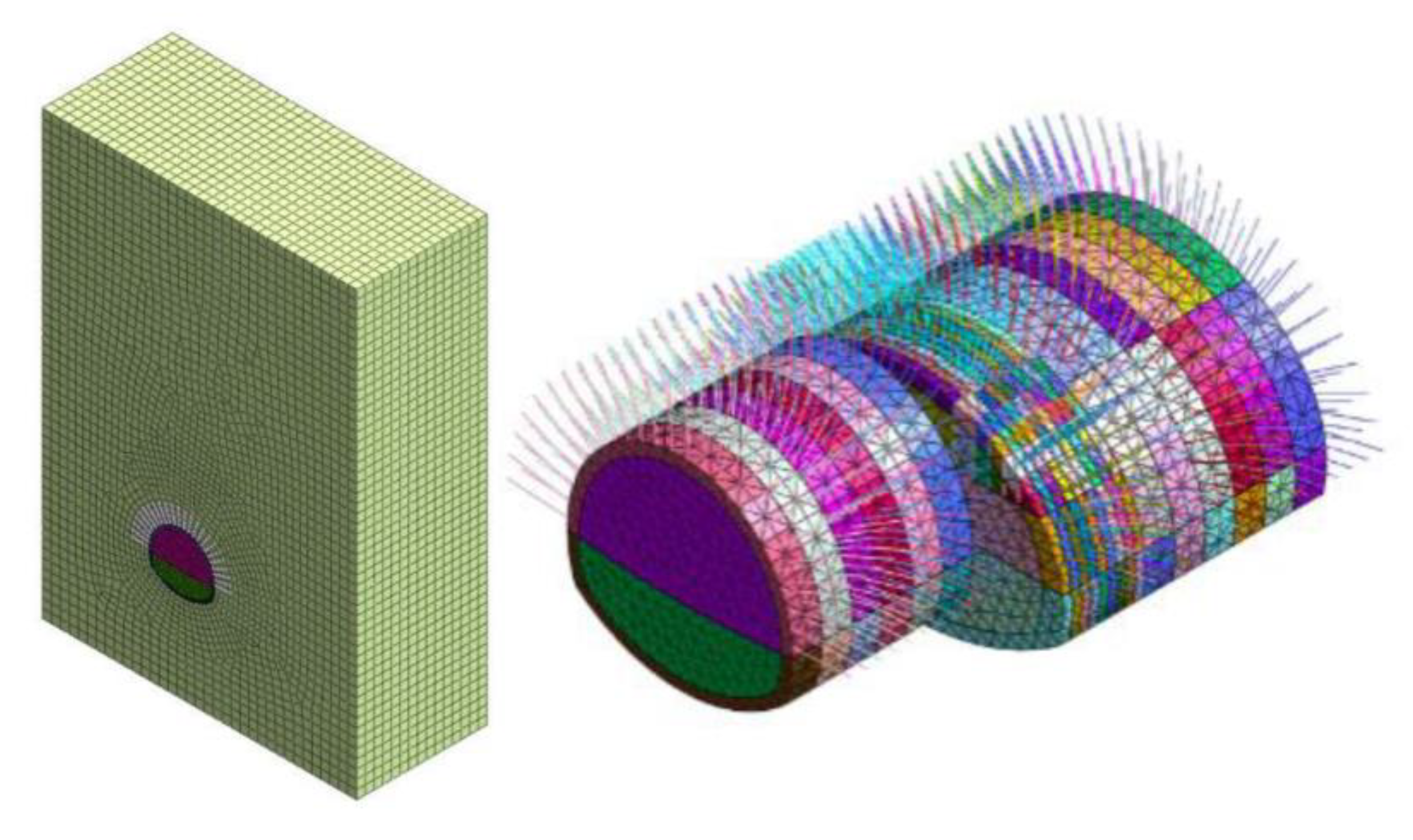

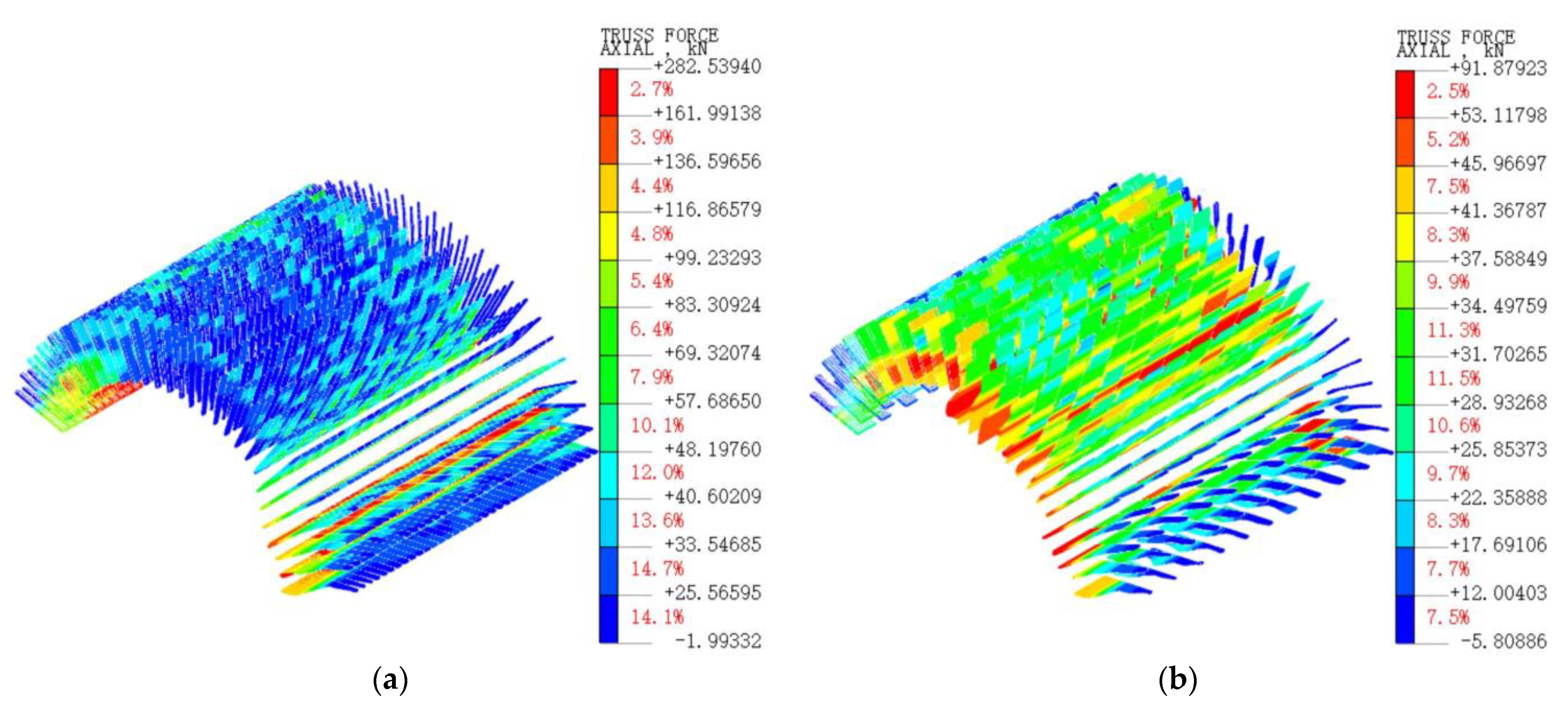



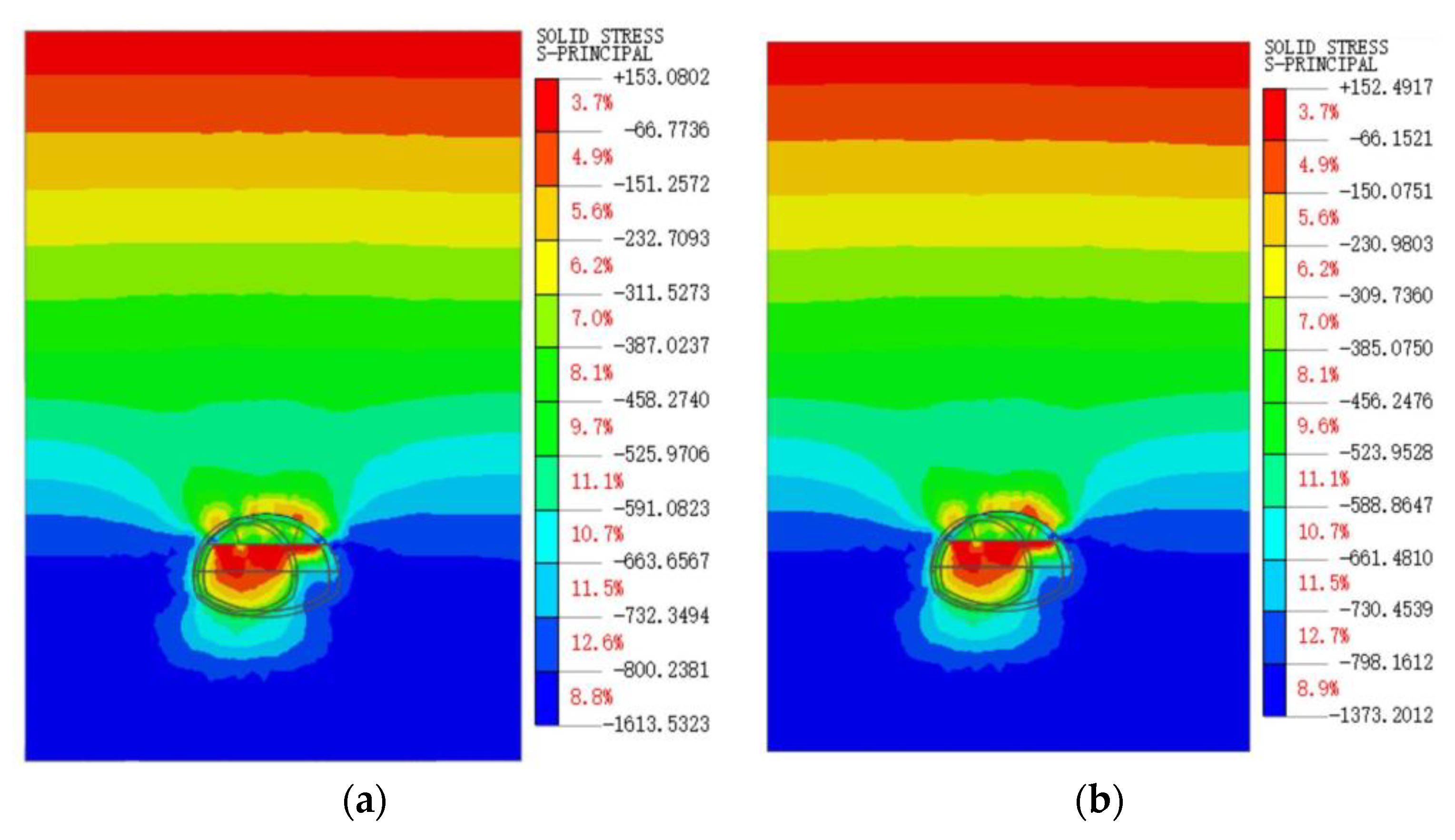
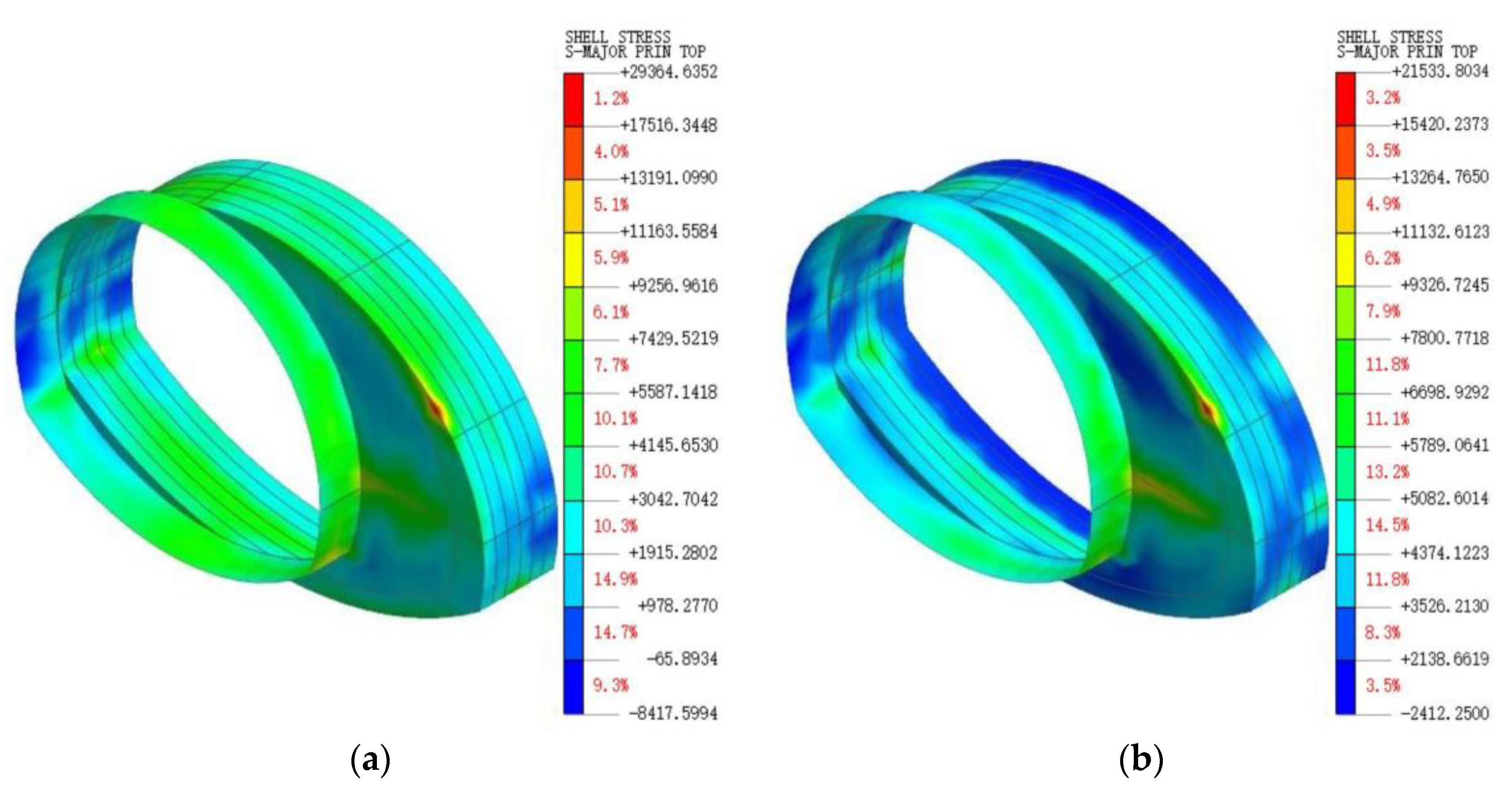

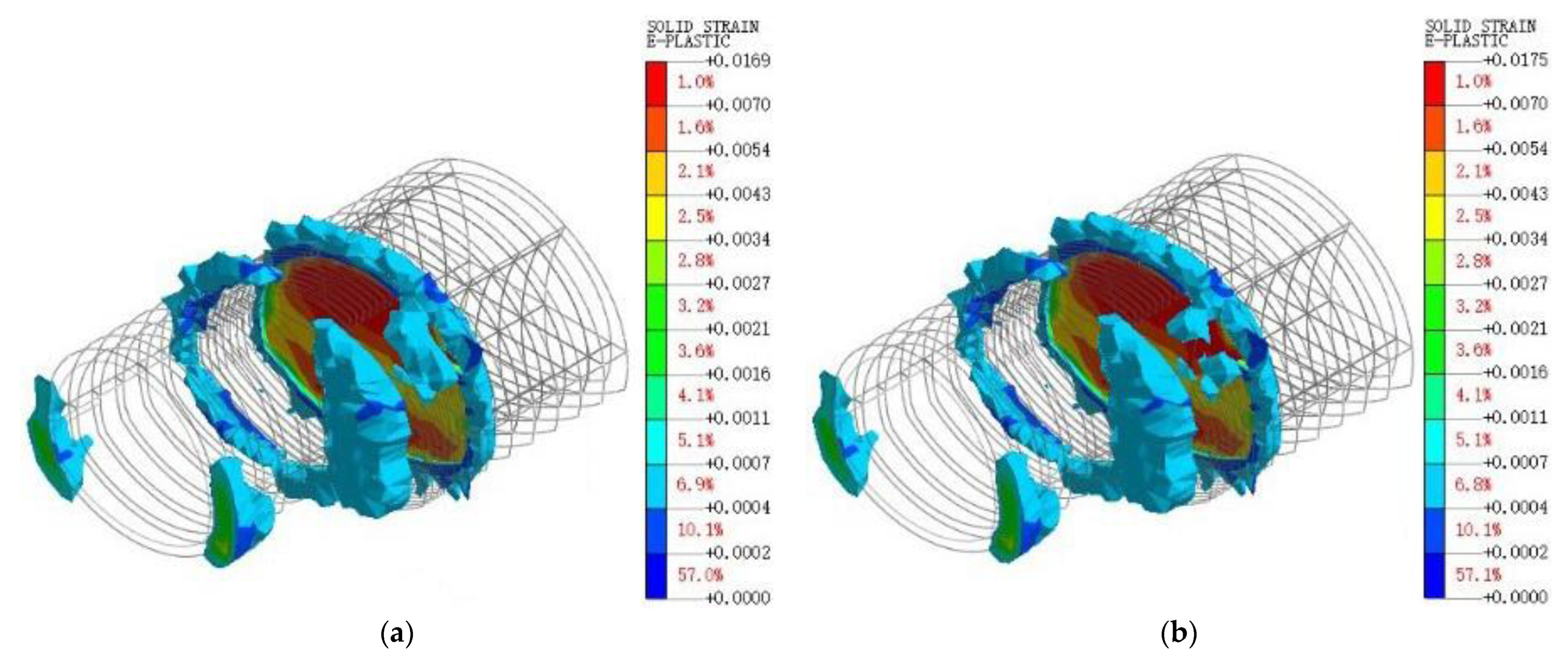
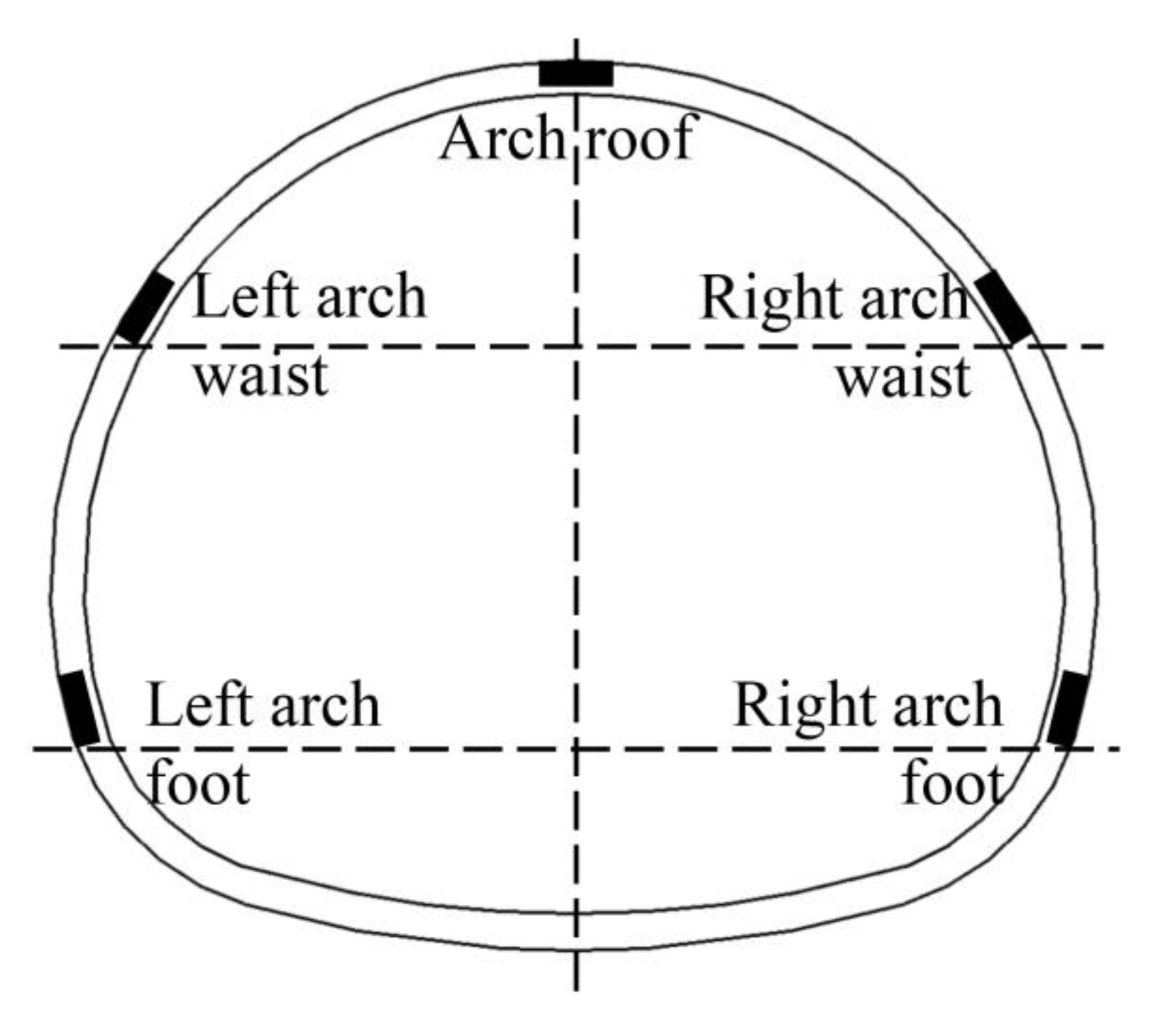



| Material | Natural Unit Weight (kN·m−3) | Elastic Modulus (GPa) | Poisson’s Ratio | Internal Friction Angle (°) | Cohesion (kPa) |
|---|---|---|---|---|---|
| Mudstone | 22.00 | 21.1 | 0.36 | 35 | 30 |
| Initial support | 24.20 | 31.6 | 0.21 | — | — |
| Temporary support | 24.81 | 32.6 | 0.21 | — | — |
| Secondary lining | 22.32 | 32.6 | 0.20 | — | — |
| Bolt | 77.00 | 210.0 | 0.30 | — | — |
| Monitoring Content | Small-Span Monitoring Section | Transition Section Monitoring Section | Large-Span Monitoring Section |
|---|---|---|---|
| Arch roof settlement Arch waist convergence Arch foot convergence | DK43 + 110 DK43 + 120 DK43 + 130 DK43 + 140 | DK43 + 150 DK43 + 155 DK43 + 160 | DK43 + 180 DK43 + 190 DK43 + 200 DK43 + 210 |
| Displacement Types | Small-Span Section | Transitional Section | Large-Span Section | |||||||||
|---|---|---|---|---|---|---|---|---|---|---|---|---|
| Section | Monitoring Value | Simulated Value | Deviation Value | Section | Monitoring Value | Simulated Value | Deviation Value | Section | Monitoring Value | Simulated Value | Deviation Value | |
| Arch roof settlement | DK43 + 140 | 19.26 | 16.45 | 2.81 | DK43 + 160 | 17.20 | 14.52 | 2.68 | DK43 + 210 | 21.41 | 17.42 | 3.99 |
| DK43 + 130 | 17.02 | 12.46 | 4.56 | DK43 + 155 | 16.78 | 14.13 | 2.65 | DK43 + 200 | 18.93 | 16.97 | 1.96 | |
| DK43 + 120 | 15.90 | 10.45 | 5.45 | DK43 + 150 | 12.09 | 9.52 | 2.57 | DK43 + 190 | 17.64 | 13.44 | 4.20 | |
| DK43 + 110 | 16.92 | 13.45 | 3.47 | — | — | — | — | DK43 + 180 | 15.01 | 9.89 | 5.12 | |
| Arch waist convergence | DK43 + 140 | 9.91 | 9.03 | 0.88 | DK43 + 160 | 3.40 | 2.54 | 0.86 | DK43 + 210 | 5.77 | 4.63 | 1.14 |
| DK43 + 130 | 14.57 | 13.68 | 0.89 | DK43 + 155 | 5.32 | 5.24 | 0.08 | DK43 + 200 | 10.65 | 8.99 | 1.66 | |
| DK43 + 120 | 13.56 | 12.21 | 1.35 | DK43 + 150 | 3.24 | 2.47 | 0.77 | DK43 + 190 | 13.65 | 12.42 | 1.23 | |
| DK43 + 110 | 14.12 | 13.64 | 0.48 | — | — | — | — | DK43 + 180 | 14.55 | 12.97 | 1.58 | |
| Arch foot convergence | — | — | — | — | DK43 + 160 | 1.30 | 1.02 | 0.28 | DK43 + 210 | 0.84 | 0.69 | 0.15 |
| — | — | — | — | DK43 + 155 | 2.76 | 2.64 | 0.12 | DK43 + 200 | 6.48 | 5.91 | 0.57 | |
| — | — | — | — | DK43 + 150 | 3.16 | 3.12 | 0.04 | DK43 + 190 | 9.51 | 9.38 | 0.13 | |
| — | — | — | — | — | — | — | — | DK43 + 180 | 13.52 | 12.45 | 0.98 | |
Disclaimer/Publisher’s Note: The statements, opinions and data contained in all publications are solely those of the individual author(s) and contributor(s) and not of MDPI and/or the editor(s). MDPI and/or the editor(s) disclaim responsibility for any injury to people or property resulting from any ideas, methods, instructions or products referred to in the content. |
© 2023 by the authors. Licensee MDPI, Basel, Switzerland. This article is an open access article distributed under the terms and conditions of the Creative Commons Attribution (CC BY) license (https://creativecommons.org/licenses/by/4.0/).
Share and Cite
Song, S.; Li, S.; Liang, Y.; Huo, R.; Song, Z.; Miao, Z.; Song, Z. Study on Construction Mechanical Effect and Optimization of Large-Span Variable Cross-Section of Railway Tunnel. Buildings 2023, 13, 2859. https://doi.org/10.3390/buildings13112859
Song S, Li S, Liang Y, Huo R, Song Z, Miao Z, Song Z. Study on Construction Mechanical Effect and Optimization of Large-Span Variable Cross-Section of Railway Tunnel. Buildings. 2023; 13(11):2859. https://doi.org/10.3390/buildings13112859
Chicago/Turabian StyleSong, Sensen, Shuguang Li, Yanling Liang, Runke Huo, Zhanping Song, Zizhen Miao, and Ziyi Song. 2023. "Study on Construction Mechanical Effect and Optimization of Large-Span Variable Cross-Section of Railway Tunnel" Buildings 13, no. 11: 2859. https://doi.org/10.3390/buildings13112859
APA StyleSong, S., Li, S., Liang, Y., Huo, R., Song, Z., Miao, Z., & Song, Z. (2023). Study on Construction Mechanical Effect and Optimization of Large-Span Variable Cross-Section of Railway Tunnel. Buildings, 13(11), 2859. https://doi.org/10.3390/buildings13112859






